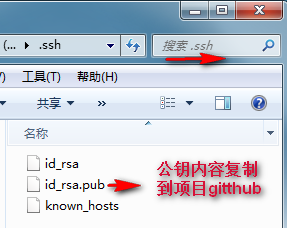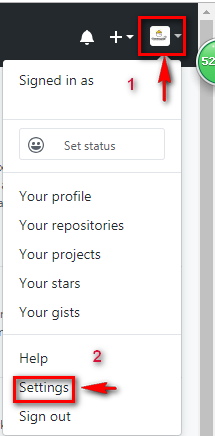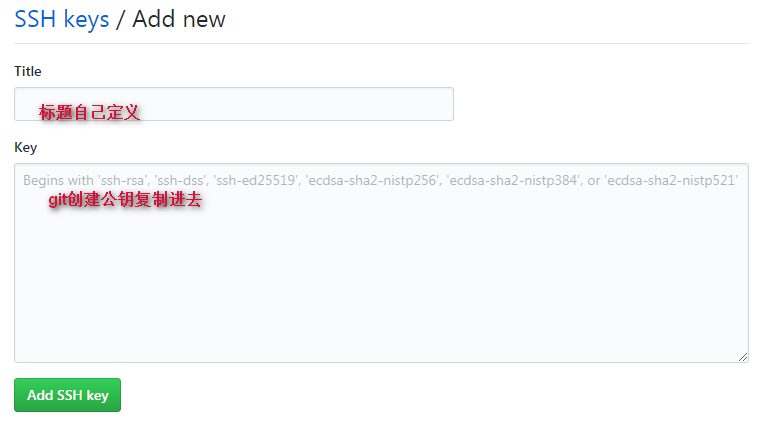Original Address: https://www.cnblogs.com/cxx8181602/p/11125539.html
git configuration https and ssh password free
A. Distinction https clone and ssh clone
Different clones in different ways resulting in parity mode, the corresponding free secret embodiment are not the same.
https by account passwords to remember Bintang, ssh key verification generated by Bintang. Usually use ssh check.
Free Density Method two .https
Setting Configuration .git / config
git config --global credential.helper store
[credential]
helper = store
After you enter a second time will remember the account password account password.
Free Density Method three .ssh
Configuration information
git init
git config --global user.name 'username'
git config --global user.email 'users' mailboxes'
Execute commands to generate public and private keys:
ssh-keygen -t rsa
Press Enter to 3 are generally not directly write directly enter empty
Check the implementation of public-key commands:
cat ~/.ssh/id_rsa.pub
Windows file location:

github add your ssh steps:



clone project get:
git clone [email protected]: 'Project url'
git common operations command
Submit these steps:
git status to view the status
git add. add all files modified
git status to view the status
git commit -m 'remark information' add notes
git push origin branches were committed to the branch
Branches merge master:
git checkout master cut to the master branch
git pull origin master pulling master
Git Merge branch name Origin combined merging branches need
git status check the status of
git push origin master push master
--git local project code uploaded to a remote warehouse operations:
Initialization: git the init
Local first installed git, configure basic information: git config -, Ltd. Free Join user.name 'username' git config --global user.email 'users' mailboxes'
Local warehouse and associated remote repository:
git the Add Remote Origin 'project url'
updates, and make sure there is no conflict with remote warehouse code:
git pull --rebase Origin Master
copy the project to, ready to upload at a local git directory.
Operating submitted master steps:
git the Add.
Git Status
git the commit -m 'remarks information'
git the Push Origin master -f for the first time, forced to submit master branch. (Submit best not to use later!)
- File directory operations command
mkdir * * Create an empty directory refers to the directory name
pwd displays the current directory path.
* cat * View file content
git rm * delete files **
--git initialization
git init becomes the current directory git repository, generate hidden .git file.
git remote add origin url to content pushed to the local repository GitHub repository.
git clone git@url/test.git library clones from a remote
git add * x add files to the staging area to go.
git commit -m "*" submission -m back is a comment.
--git clone branch
git clone xxx.git most straightforward command
git clone xxx.git "specified directory" clone to a specified directory
git to create a new branch instead of the default Origin HEAD (master) when clone clone -b branchname xxx.git
- View command
git status to view the status of the warehouse
git diff * View X Files modify the content of those
git log to view the history
git reflog view the history of the version number id (record your every command, whether or not submitted)
git log --pretty = oneline if the information the amount can be much better display list
- version rollback
git reset -hard HEAD ^ fall back to the previous version
git reset --hard HEAD ~ If you want to roll back to the first of several third version, use the RESET -hard the HEAD ~ 3 git
git a fallback to the RESET --hard 057d a specific version number
- undo changes
git checkout file-name restore a file has been modified (modifications withdraw uncommitted):
git revert to modify the HEAD Revert last submitted:
git Revert to restore the commit-specific version of the above mentioned id modification
- Branch Management
View all git branch local branch
git branch -a view of all remote branch
git branch name to create a branch
git branch -d dev delete dev branch
git push origin --delete dev dev delete remote branch
git branch -m dev develop rename branch
git checkout -b dev dev branches create and switch to the dev branch
git merge dev on behalf of the current branch merging branch dev
git push origin zyf-dev the current branch Xinjiang zyf-dev pushed to a remote database (not to branch is remote repository this will establish a new branch)
git Checkout - * XX to withdraw all files modified in the workspace.
git checkout master switch back to the master branch
git push --set-upstream origin dev commit changes and create a remote branch dev
--tag related operations
git tag lists all the tag
git tag name to play light tag name
git tag -d delete the local name tag
git the Push Origin --delete delete the tag name tag remote
git show name tag to view information
git push origin name tag will be submitted to the Remotely
- hidden files
git stash the current job hiding Once after recovery site continue to work
git stash list to view all the hidden files list
git stash apply recover hidden files, but the content does not remove
git stash drop deleted files
git stash pop to recover files at the same time also delete files
- View information about the remote repository (git remote usage)
git remote viewing remote database information
git remote -v view the remote database details
git remote add name url add a remote repository
git remote rename oldname newname rename warehouse
git remote rm delete warehouse
- the remote to the local branch pulled
Method a: git checkout -b local branch name x origin / remote branch name x
Second way: git fetch origin remote branch name x: x local branch name
--git pull operation
git pull action command is to retrieve a branch update the remote host, and then combined with the specified local branch, the basic format is as follows.
$ Git pull <remote host name> <remote branch name>: <local branch name>
to retrieve origin host next branch and the local branch of the merger master, takes on the form below so
$ git pull origin next: master
If the remote branch is the combined current branch, the portion of the colon may be omitted.
$ Git pull origin next
command above said retrieved origin / next branch, and then merged with the current branch. In essence, this is equivalent to do first git fetch, do git merge.
Origin git FETCH $
$ git Merge Origin / the Next
in some cases, Git automatically between the local branch and a remote branch, to establish a relationship tracking (tracking). For example, when git clone, the
same name as the local branches of all branches of default remote host, a tracking relationship, that is, the local master branch automatic "track" origin / master branch.
Git also allows the track to establish relationships manually.
git branch --set-upstream master origin / next
upper branch command specifies master tracking origin / next branch. If the current relationship between the presence of trace branch and remote branch, git pull will be omitted remote branch name.
$ Git pull origin